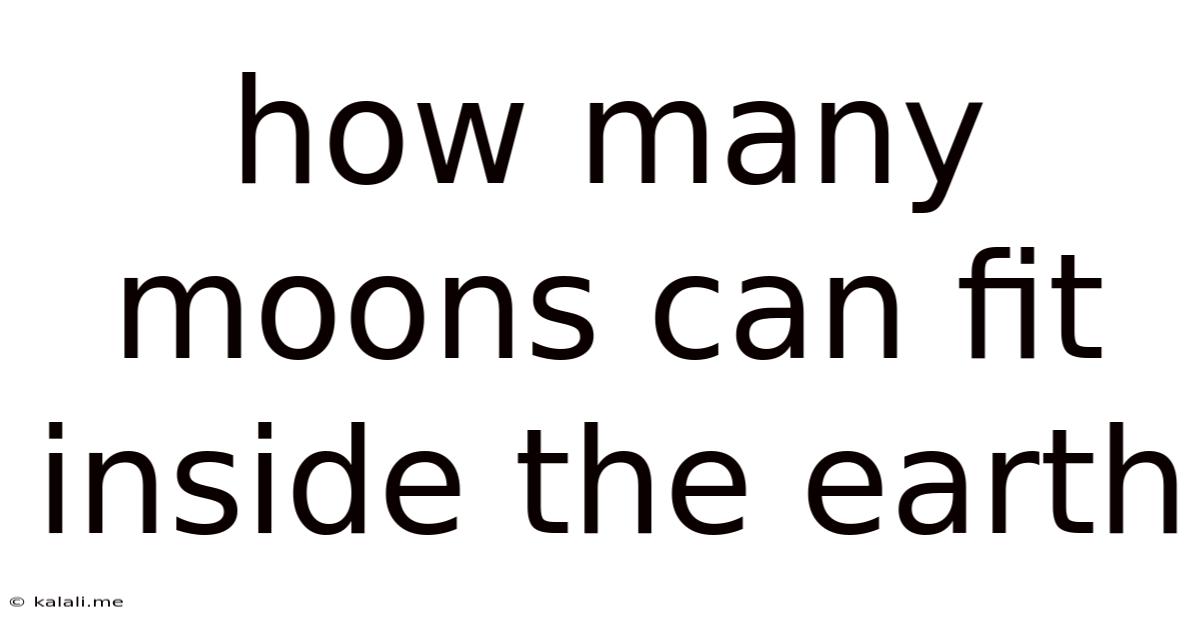How Many Moons Can Fit Inside The Earth
Kalali
Aug 10, 2025 · 4 min read

Table of Contents
How Many Moons Can Fit Inside the Earth? A Celestial Packing Problem
This question, seemingly simple, delves into fascinating aspects of planetary science, geometry, and the sheer scale of the cosmos. It's not just about simple division; it requires understanding the shapes and volumes of both the Earth and its moon, and acknowledging the complexities of "fitting" one inside the other. This article will explore the various methods of calculating this, highlighting the challenges and offering a comprehensive answer. We'll also delve into related celestial mechanics and the implications of such a thought experiment.
Understanding the Shapes and Sizes
Before we begin calculating how many moons could theoretically fit inside the Earth, we need to establish the dimensions of both celestial bodies. We'll use simplified models for the sake of calculation, acknowledging that both Earth and the Moon are not perfect spheres.
-
Earth: The Earth's mean radius is approximately 6,371 kilometers (3,959 miles). Using this radius, we can calculate its volume using the formula for the volume of a sphere: (4/3)πr³. This gives us a volume of approximately 1.08321×10<sup>12</sup> cubic kilometers.
-
Moon: The Moon's mean radius is approximately 1,737.4 kilometers (1,079.6 miles). Using the same formula, its volume is approximately 2.199×10<sup>10</sup> cubic kilometers.
Method 1: Simple Volumetric Division
The most straightforward approach is to divide the Earth's volume by the Moon's volume. This gives us a theoretical number of moons that could fit inside the Earth if they could be perfectly packed without any gaps.
1.08321×10<sup>12</sup> cubic kilometers (Earth's volume) / 2.199×10<sup>10</sup> cubic kilometers (Moon's volume) ≈ 49.24
This suggests that approximately 49 moons could fit inside the Earth if we could perfectly pack them into the Earth's volume, like stacking oranges in a crate. However, this is a highly idealized scenario.
Method 2: Considering Spherical Packing Efficiency
In reality, spheres cannot be perfectly packed without leaving gaps. The most efficient way to pack spheres is in a close-packed arrangement, where spheres fill approximately 74% of the available space. This arrangement resembles the way oranges are often stacked in grocery stores.
To account for this packing inefficiency, we need to adjust our calculation:
- Number of moons (from Method 1) * Packing efficiency = 49.24 * 0.74 ≈ 36.4
This more realistic calculation suggests that approximately 36 moons could fit inside the Earth, considering the limitations of spherical packing.
Method 3: Accounting for Irregularities
Both the Earth and the Moon are not perfectly spherical. The Earth is an oblate spheroid, slightly flattened at the poles and bulging at the equator. The Moon also possesses subtle irregularities in its shape. These irregularities further complicate the packing problem, making precise calculations extremely challenging. This method requires advanced computational techniques and 3D modeling to accurately simulate the packing process, taking into account the detailed topography of both bodies. Such simulations are beyond the scope of this article, but it's crucial to acknowledge that the previous methods are approximations.
Beyond Simple Packing: Celestial Mechanics and Gravity
The question of how many moons can fit inside the Earth also highlights the complexities of celestial mechanics and gravity. If we were to somehow magically place multiple moons inside the Earth, several factors would come into play:
-
Gravitational Interactions: The moons' gravitational pull on each other and on the Earth's interior would be immense, causing significant disturbances. The Earth's internal structure and possibly even its surface would be dramatically altered.
-
Tidal Forces: The moons' gravitational pull would create powerful tidal forces within the Earth, potentially leading to earthquakes, volcanic eruptions, and significant changes in the planet's rotation and axial tilt.
-
Material Compression: The immense pressure from the weight of multiple moons would compress the material within the Earth, leading to changes in its density and composition.
The Importance of the Thought Experiment
While the precise number of moons that could fit inside the Earth remains a complex calculation with a range of possible answers depending on the method used, the thought experiment itself is valuable for several reasons:
-
Understanding Scale: It helps to grasp the sheer scale of celestial bodies and the vast differences in their sizes and volumes.
-
Exploring Geometric Concepts: It introduces concepts like spherical packing efficiency and the limitations of simplified models when dealing with real-world objects.
-
Highlighting Celestial Mechanics: It underscores the complexities of gravitational interactions and the challenges of modeling such scenarios.
Conclusion: A Range of Answers, a Wealth of Learning
In conclusion, a simple volumetric division suggests that approximately 49 moons could fit inside the Earth. However, accounting for spherical packing efficiency reduces this number to roughly 36. Considering the irregularities in the shapes of both the Earth and the Moon, and the complexities of gravity and celestial mechanics, the actual number remains a complex question that requires advanced computational methods. Regardless of the precise numerical answer, the exercise provides valuable insights into the scale of our solar system, the nature of celestial bodies, and the fascinating interplay of geometry, physics, and astronomy. The seemingly simple question of how many moons can fit inside the Earth opens up a universe of exploration and learning.
Latest Posts
Latest Posts
-
55 Gallon Drum Inches To Gallons Chart
Aug 14, 2025
-
How Many Pieces Of Candy Corn In A Bag
Aug 14, 2025
-
How Do You Spell A Howling Sound
Aug 14, 2025
-
How Many Ml Are In A Meter
Aug 14, 2025
-
None So Blind As Those Who Cannot See
Aug 14, 2025
Related Post
Thank you for visiting our website which covers about How Many Moons Can Fit Inside The Earth . We hope the information provided has been useful to you. Feel free to contact us if you have any questions or need further assistance. See you next time and don't miss to bookmark.